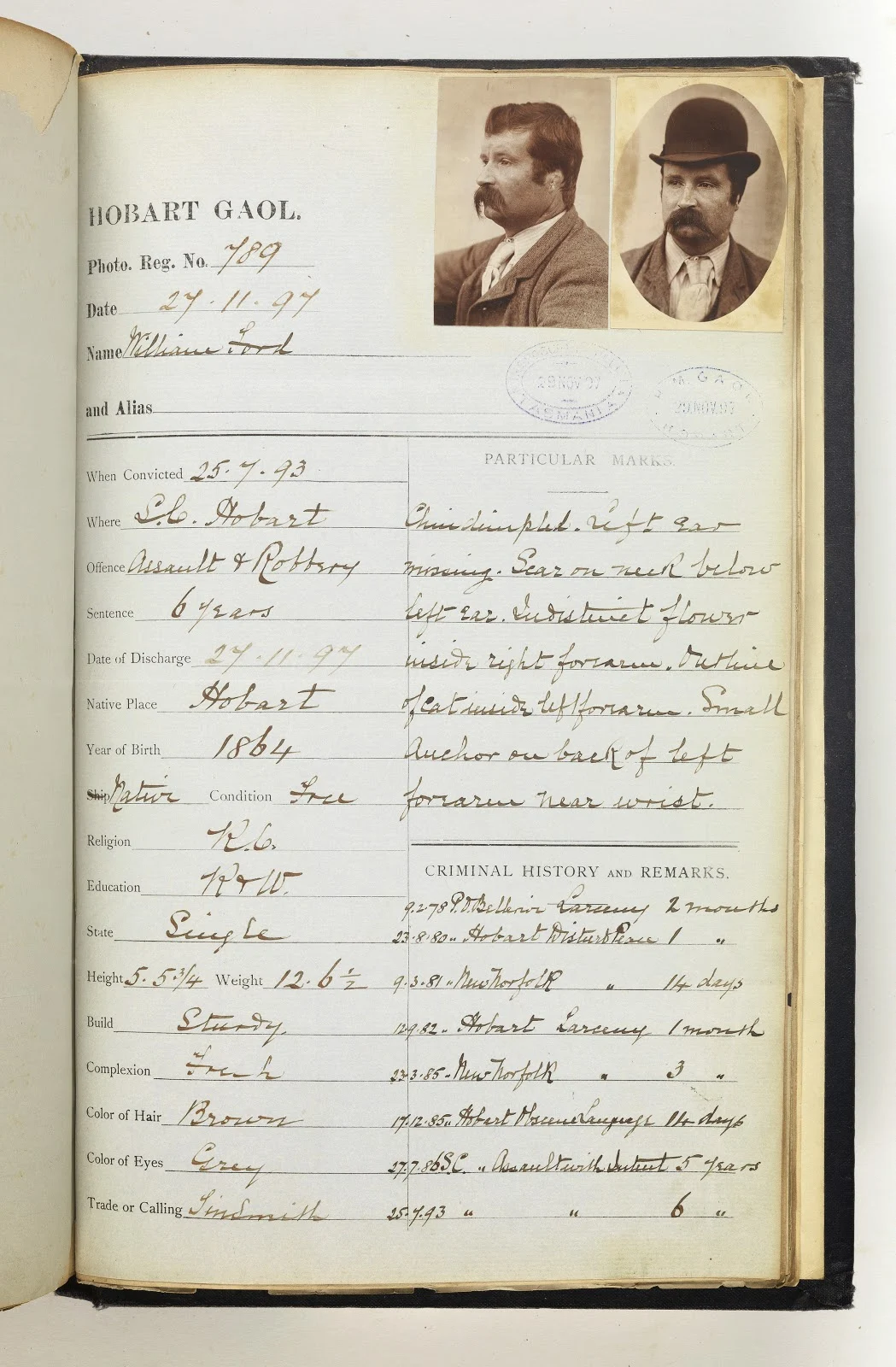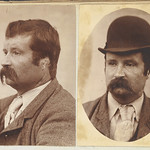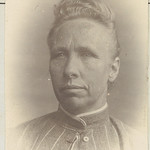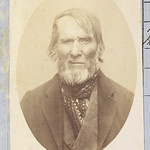TEENAGE MURDERERS James Sutherland and Robert Ogden
DEATH WARRANT with hand-tinted mugshot by T. J. NEVIN
NEVIN FAMILY Collections at the State Library of NSW

Prisoner Robert Ogden (1861?-1883), known as James Odgen,
Executed on 4th June 1883 at the Hobart Goal for murder.
Photographed by Thomas J. Nevin at the Hobart Gaol, 23 September 1875.
Source of image: State Library of NSW
Miscellaneous Photographic Portraits ca. 1877-1918
36. James Ogden
Photographs : 54 silver gelatin photoprints, 2 albumen photoprints ; 7.8-21.3 x 5.8-17.5 cm.
Link: https://collection.sl.nsw.gov.au/record/YezVeZW9/QlkmJb0R6a2PQ
 Source: Tasmania Reports of Crime (police gazette), 13 April 1883
TRANSCRIPT
Source: Tasmania Reports of Crime (police gazette), 13 April 1883
TRANSCRIPT
"Referring to murder of William Wilson, James Ogden, proper name Robert Ogden, and James Mahoney, alias Sutherland, have been arrested by P. C. Phillips. of the Campbell Town Municipal Police, and party. Ogden and Mahoney are also charged with the murder of Alfred Holman."
This photograph - a standard 1870s carte-de-visite prisoner mugshot in an oval mount produced by Thomas J. Nevin - has escaped the attention of photo-historians of the 1870s Tasmanian prisoners' identification photographs, the so-called "
Convict portraits, Port Arthur 1874" labelled and catalogued as such in Australian national collections, viz. the National Library of Australia, Canberra, the Tasmanian Museum and Art Gallery, Hobart and the Queen Victoria Museum and Art Gallery, Launceston. It belongs to the same series of fine albumen prints in oval mounts of prisoners taken by commercial and police photographer Thomas J. Nevin for the HCC Municipal Police Office and Hobart Gaol authorities from 1872 to the mid 1880s.
Only 300 or so are currently extant from the thousand or more produced over two decades by Thomas J. Nevin and his younger brother Constable John Nevin in Hobart's courts and prisons for the central registry, the Municipal Police Office, Hobart Town Hall. Up to 25 duplicates were being taken on arrest and discharge of prisoners in NSW by 1872 and a comparable number was produced in Victoria. In Tasmania Thomas Nevin produced on average four duplicates from his original capture on glass. If the prisoner repeatedly offended and was sentenced within a short period, the glass plate was used again and again until it became damaged (see
Peter Killeen's record). Additional sittings with the prisoner and new photographs were taken if the prisoner repeatedly offended over years extending into decades. In Victoria, South Australia and Tasmania in the 1870s, the police used commercial photographers.
The photograph (above) of Robert Ogden (aka James Ogden) is held at the State Library of NSW, catalogued as "
No. 36 James Ogden, Miscellaneous Photographic Portraits ca. 1877-1918 " (DL PX 158). It bears no attribution, no studio mark or inscription, except the name of the prisoner on verso. The fact that it is a mugshot of a prisoner is not stated. The name "James Ogden" was written no doubt by its donor to the State Library of NSW, John Watt Beattie, who admired Thomas Nevin's photography of prisoners taken in the 1870s to warrant their salvage for commercial advantage as Port Arthur souvenirs for the burgeoning dark tourism trade of the 1890s.
Most in this miscellany are portraits of notable men and women.
No. 25 is catalogued as "
Le Grande [sic] Bookseller Hobart, d. Nov. 1902 / J. W. Beattie, Hobart". There is little doubt that it was John Watt Beattie, collector and dealer in convictaria in Hobart from the 1890s, and Tasmanian government photographer from 1895, who contributed this 1870s prisoner mugshot by Thomas Nevin, along with dozens more that he had salvaged from the Hobart Gaol (held at SLNSW PXB 274) for inclusion in an intercolonial travelling exhibition in conjunction with the fake convict ship
Success.
This cdv of prisoner Robert Ogden found its way to the State Library of NSW, along with
Beattie's own photograph of the conchologist William Legrand before 1907. The Ogden mugshot belongs with the other collection of eleven Thomas J. Nevin photographs of Tasmanian prisoners catalogued in the David Scott Mitchell Collection, Mitchell Library, State Library NSW at PXB 274. An additional hand-coloured prisoner mugshot by Thomas Nevin, pasted next to the death warrant of Ogden’s accomplice, James Sutherland, is also held in the David Scott Mitchell collection (Tasmania Supreme Court - Death warrants and related papers, 1818-1884 - see below). Other Nevin family materials held in the same collection include a published copy of Thomas J. Nevin’s father’s poem, “
My Cottage in the Wilderness” (1868) by John Nevin snr. These and other selections of Tasmaniana were contributed to David Scott Mitchell’s collection by John Watt Beattie in the early 1900s.

 Prisoner photographs by T. J. Nevin 1870s
Mitchell Library State Library NSW. at PXB 274
Link: https://collection.sl.nsw.gov.au/record/YzOgQ689
Photos copyright © KLW NFC Private Collection 2009
Prisoner photographs by T. J. Nevin 1870s
Mitchell Library State Library NSW. at PXB 274
Link: https://collection.sl.nsw.gov.au/record/YzOgQ689
Photos copyright © KLW NFC Private Collection 2009
J. W. Beattie's somewhat cavalier use of Tasmanian government property from 1895 is the seminal reason why so many hundreds of prisoner portraits taken by T. J. Nevin on government contract in the 1870s were removed from the original Hobart Gaol Photo Books, prisoner rap sheets, Police Office warrants and Sheriff Office registers, to surface decades later as artistic artefacts in libraries and museums, sourced as often as not from John Watt Beattie's own shop in Hobart where he sold any item he could associate with the "Port Arthur" brand. Beattie's name has become associated with early to mid-19th century photographic Tasmaniana to the point where he is sometimes attributed as the original photographer, although this is chronologically impossible. John Watt Beattie was still a teenager living in Scotland when Thomas J. Nevin took this particular prisoner identification photograph of Robert aka James Ogden in 1875.
Police Records for Robert aka James OGDEN
These police records are sourced from the Tasmanian police gazettes 1870-85, published as
Tasmania Reports of Crime, Information for Police; James Barnard, Government Printer.
1870-1872
The early police reports note that Robert Ogden was undergoing a sentence of 4 years passed on him 29 October 1870 at Green Ponds for being idle and disorderly, and vagrancy. His age was indeterminate to police, sometimes described as 12, or 15, or 16 yrs old, or "short for his age" . By the time he was executed in 1883, he was thought to be about 20 yrs old.
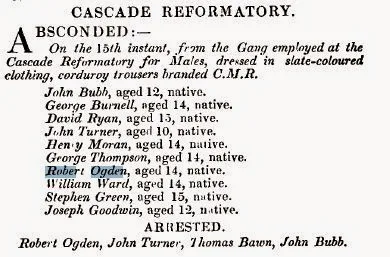
Source:
Tasmania Reports of Crime for Police, 19 January 1872
Absconded and arrested: Robert Ogden, aged 14.

Source:
Tasmania Reports of Crime for Police, 27 January 1872.
A more detailed description of the two brothers, Robert and William Ogden, who were sometimes confused with each other by unsuspecting police. In this instance, Robert Ogden's age has increased 2 years in one week..

Source:
Tasmania Reports of Crime for Police, 6 December 1872
Robert Ogden arrested with his brother William, but Robert absconded again within weeks.

Source:
Tasmania Reports of Crime for Police, 27 December 1872
Almost a year later, Robert Ogden's age has decreased by one year.
1873

Source:
Tasmania Reports of Crime for Police, 3 October 1873
Absconded again, Robert Ogden is thought to be 14 yrs old, one year younger not older.

Source:
Tasmania Reports of Crime for Police, 18 October 1873
Convicted of larceny, age put at 12 yrs old.


Source:
Tasmania Reports of Crime for Police, 12 December 1873
Absconded, and then arrested in the same week. Robert Ogden is now described as 11 yrs old, perhaps because he was "short for his age".
1875

Source:
Tasmania Reports of Crime for Police, 6 August 1875
Absconded, now described as a 12 yr old.

Source:
Tasmania Reports of Crime for Police, 20 August 1875
On the run still, and wanted for larceny.

Source:
Tasmania Reports of Crime for Police, 24 September 1875
Robert Ogden arrested, sent to the Hobart Goal, and
photographed by Thomas J. Nevin
1878

Source:
Tasmania Reports of Crime for Police, 14 December 1878
Described as 18 yrs old, Robert Ogden was convicted for larceny for 3 months at the Hobart Gaol.
1879

Source:
Tasmania Reports of Crime for Police, 12 March 1879
Discharged 6 months later, aged 19 yrs.
1880

Source:
Tasmania Reports of Crime for Police, 8 May 1880
Arrested for stealing bread etc.
1881

Source:
Tasmania Reports of Crime for Police, 28 January 1881
Arrested again.
1883
William Wilson, of Epping Forest (Tasmania). the murder victim, awoke to the sound of stones thrown onto his roof and went out to investigate. He was shot and died of his wounds. His hut - where his wife and children slept - was then set on fire. Ogden and Sutherland claimed they only intended it all as a joke.

Source:
Tasmania Reports of Crime for Police, 3 April 1883
Inquests of the murder victims of Robert aka James Ogden and James Sutherland.

Source:
Tasmania Reports of Crime for Police, 13 April 1883
"Referring to murder of William Wilson, James Ogden, proper name Robert Ogden, and James Mahoney, alias Sutherland, have been arrested by P. C. Phillips. of the Campbell Town Municipal Police, and party. Ogden and Mahoney are also charged with the murder of Alfred Holman."

Source:
Mercury, 2 June 1883. Execution of Ogden and Sutherland determined, visited by Executive Council members who did not detect "
the presence of insanity in either of them".
Photographers at the Murder Scene

Source:
Mercury, 8 May 1883:
The Anson Brothers – not unfamiliar to police as convicted felons themselves (in 1877 Joshua Anson was convicted for theft from his master, photographer H.H. Baily, and sentenced to two years, Henry Anson was frequently arrested for drunkenness) – turned up at the burnt-out house of Ogden and Sutherland’s victim Mr Wilson just weeks into the aftermath of the murder, took photographs of the ruins – described as “
a subject of mournful yet engrossing interest” by the
Mercury report – and coolly advised the public that “
handsome, interesting and valuable” copies were available from the photographers! The Ansons went further in pursuit of gain: they probably accessed the two doomed youths Sutherland (on left) and Ogden (on right) inside the Hobart Gaol only weeks before their execution to grab this image for sale and display in the window of their shop at Wellington Bridge, Elizabeth Street, Hobart.
 James Sutherland and Robert Ogden in prison uniform April 1883
Tasmanian Museum and Art Gallery
Ref: Q16478. Unattributed.
James Sutherland and Robert Ogden in prison uniform April 1883
Tasmanian Museum and Art Gallery
Ref: Q16478. Unattributed.
Thomas J. Nevin photographed Robert Ogden’s accomplice, James Mahoney aka James Sutherland in prisoner clothing, for two standard mugshots required as police records: one photograph is held at the National Library of Australia, the other – a hand-coloured carte--de-visite pasted next to Sutherland’s death warrant – is held at the Mitchell Library, SLNSW.

 Prisoner James Sutherland, recto and verso inscribed with the date 29.5.83
Photographer: Thomas J. Nevin, Hobart Gaol April 1883
National Library of Australia PIC Album 935 P1029/43
Prisoner James Sutherland, recto and verso inscribed with the date 29.5.83
Photographer: Thomas J. Nevin, Hobart Gaol April 1883
National Library of Australia PIC Album 935 P1029/43
 Detail of hand-tinted prisoner mugshot of James Sutherland pasted to his death warrant (below).
Photographed at the Hobart Gaol by Thomas J. Nevin 1883
Photo copyright © KLW NFC Imprint 2009
Detail of hand-tinted prisoner mugshot of James Sutherland pasted to his death warrant (below).
Photographed at the Hobart Gaol by Thomas J. Nevin 1883
Photo copyright © KLW NFC Imprint 2009
This is one seven extant
mugshots of Tasmanian "convicts" by T. J. Nevin which were hand-tinted at the time of printing. The colouring served two purposes: to render a more accurate image reflective of reality, i.e. blue for blue eyes, blue for the prison issue scarf, especially when the man was wanted on warrant; and to profit from the sale of the hanged man's image to the press and the public. These were called "ornaments of colour", a term used in reference to Thomas Nevin's tinting of prisoner photographs in the
Mercury newspaper account of Nevin's incident with the "ghost" (December 4, 1880).
 Left hand page:
Hand-tinted prisoner identification photograph of James Sutherland by Thomas Nevin 1880s
Right hand page:
Death warrant for James Sutherland signed 23 May 1883 by Francis Smith JP
Photo copyright © KLW NFC Imprint 2009
Tasmania. Supreme Court - Death warrants and related papers, 1818-1884
Date of Work: 1818 - 1884
Call Number: C 202 - C 203
Link: https://collection.sl.nsw.gov.au/record/nX6Oqj8Y
State Library of NSW
Left hand page:
Hand-tinted prisoner identification photograph of James Sutherland by Thomas Nevin 1880s
Right hand page:
Death warrant for James Sutherland signed 23 May 1883 by Francis Smith JP
Photo copyright © KLW NFC Imprint 2009
Tasmania. Supreme Court - Death warrants and related papers, 1818-1884
Date of Work: 1818 - 1884
Call Number: C 202 - C 203
Link: https://collection.sl.nsw.gov.au/record/nX6Oqj8Y
State Library of NSW
RELATED ARTICLES main weblog



